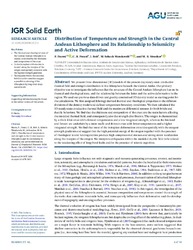Distribution of Temperature and Strength in the Central Andean Lithosphere and Its Relationship to Seismicity and Active Deformation
DOI: https://doi.org/10.1029/2020JB021231
Persistent URL: http://resolver.sub.uni-goettingen.de/purl?gldocs-11858/9569
Persistent URL: http://resolver.sub.uni-goettingen.de/purl?gldocs-11858/9569
Ibarra, F.; Prezzi, C. B.; Bott, J.; Scheck‐Wenderoth, M.; Strecker, M. R., 2021: Distribution of Temperature and Strength in the Central Andean Lithosphere and Its Relationship to Seismicity and Active Deformation. In: Journal of Geophysical Research: Solid Earth, Band 126, 5, DOI: 10.1029/2020JB021231.
 |
Dokument öffnen: |
We present three‐dimensional (3D) models of the present‐day steady‐state conductive thermal field and strength distribution in the lithosphere beneath the Central Andes. Our primary objective was to investigate the influence that the structure of the Central Andean lithosphere has on its thermal and rheological state, and the relationship between the latter and the active deformation in the region. We used our previous data‐driven and gravity‐constrained 3D density model as starting point for the calculations. We first assigned lithology‐derived thermal and rheological properties to the different divisions of the density model and defined temperature boundary conditions. We then calculated the 3D steady‐state conductive thermal field and the maximum differential stresses for both brittle and ductile behaviors. We find that the thickness and composition of the crust are the main factors affecting the modeled thermal field, and consequently also the strength distribution. The orogen is characterized by a thick felsic crust with elevated temperatures and a low integrated strength, whereas the foreland and forearc are underlain by a more mafic and thinner crust with lower temperatures and a higher integrated strength. We find that most of the intraplate deformation coincides spatially with the steepest strength gradients and suggest that the high potential energy of the orogen together with the presence of rheological lateral heterogeneities produce high compressional stresses and strong strain localization along the margins of the orogen. We interpret earthquakes within the modeled ductile field to be related to the weakening effect of long‐lived faults and/or the presence of seismic asperities. Key Points:
The thermal and rheological state of the Central Andean lithosphere is mainly controlled by the thickness and composition of the crust.
Active intraplate deformation is located along the margins of the orogen and spatially coincides with the highest strength gradients.
Earthquakes below the modeled brittle‐ductile transition suggest a possible weakening of the lithosphere by long‐lived deep‐seated faults.
Statistik:
ZugriffsstatistikSammlung:
- Geologie [933]
This is an open access article under the terms of the Creative Commons Attribution‐NonCommercial License, which permits use, distribution and reproduction in any medium, provided the original work is properly cited and is not used for commercial purposes.

